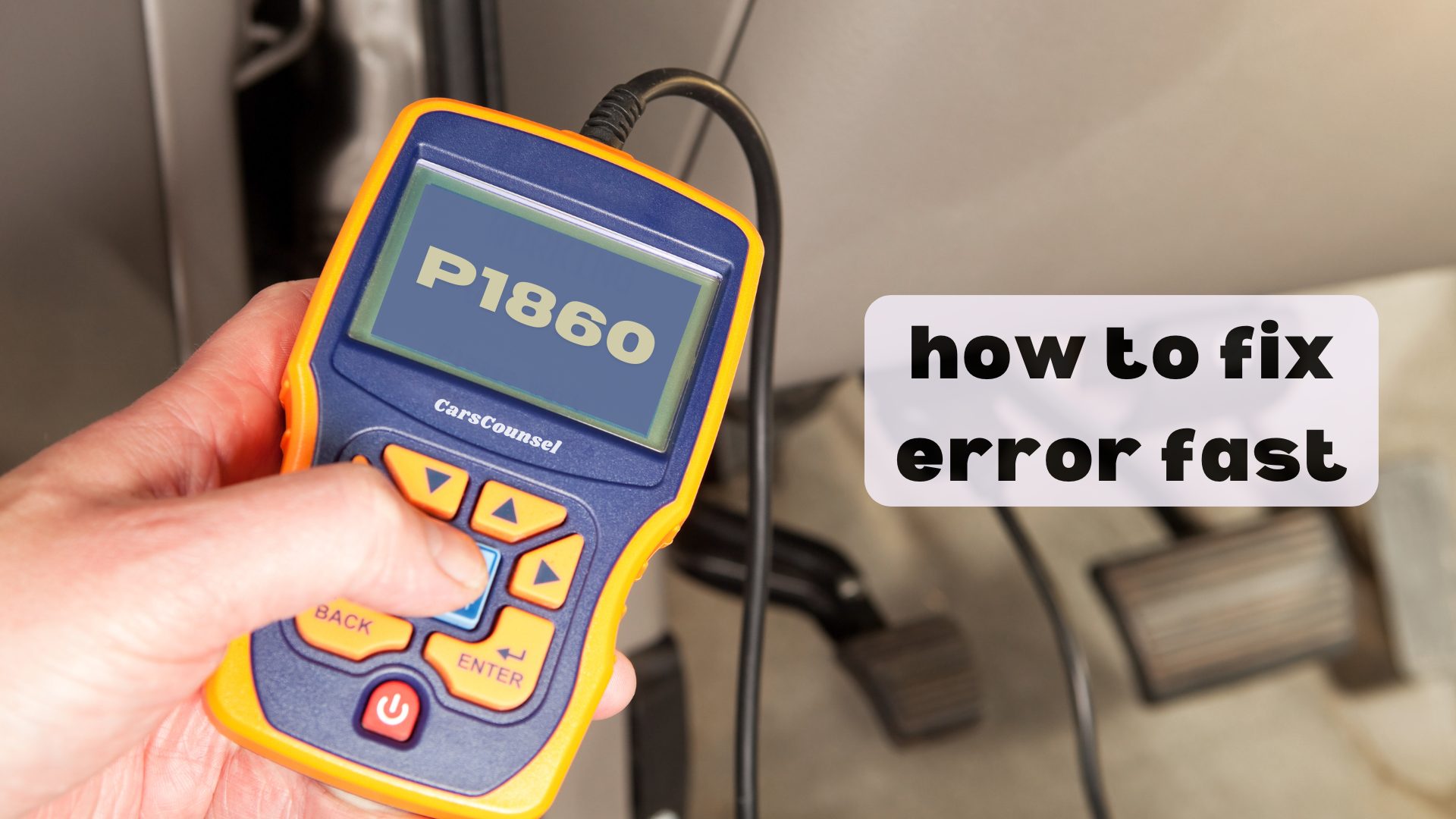When you’re dealing with the P1860 code, you need a plan to fix it quickly and efficiently.
Start by using an OBD-II scanner to confirm the error and check for any other diagnostic codes.
Next, inspect the wiring harness for any damage and make sure the connections between the Transmission Control Module (TCM) and the shift solenoid are secure and free from rust.
Use a multimeter to test the shift solenoid’s resistance; if it’s not within the normal range, you’ll need to replace it.
But don’t stop there; there’s more to consider if you want a complete fix.

Quick Navigation
Key Takeaways
- Use a code reader to confirm the P1860 error and find specific issues.
- Check the wiring for any damage, frayed wires, or loose connections.
- Use a multimeter to test the shift solenoid’s resistance for any problems.
- Make sure all electrical connections between the TCM and solenoid are tight and free of rust.
Understanding the P1860 Code
The P1860 code means there’s an issue with the transmission control system in your car, specifically with the solenoid valve circuit.
When this code shows up, it’s important to troubleshoot the problem to find out what’s wrong. You might notice symptoms like rough shifting, poor transmission performance, and the check engine light turning on. These signs indicate that the transmission control system isn’t working properly.
To start troubleshooting, use an OBD-II scanner to get the diagnostic codes. Then, check the transmission range sensor, wiring harness, and solenoid valve circuit for any issues.
Addressing the problem quickly and accurately can help keep your vehicle running smoothly.
Common Causes
When you’re trying to fix the P1860 code, you should look into a few common issues that might be messing with your transmission control system.
First, check the shift solenoids, as a bad solenoid valve can mess up how your transmission works.
Also, look at the wiring harnesses and electrical connections between the Transmission Control Module (TCM) and the solenoid; damaged wires or loose connections can cause problems too.
If those seem fine, the TCM itself might be faulty.
Check the wiring for any damage or rust, and use a multimeter to test the solenoid’s resistance to make sure it’s working right.
Make sure all electrical connections are tight and see if the TCM is in good shape.
Finding and fixing these common issues can help keep your transmission running smoothly and avoid bigger problems down the road.
Recognizing Symptoms
Spotting symptoms of a P1860 code means looking out for things like rough gear changes, poor transmission performance, and a check engine light turning on.
These signs are important because they can point to serious problems with your car’s transmission control system. You might feel the car shifting gears roughly or notice unpredictable acceleration.
These issues can start suddenly or get worse over time. It’s crucial to address them right away to avoid further damage.
Also, keep an ear out for strange noises from the transmission area or if the car goes into limp mode.
Knowing these symptoms helps you act fast, get the necessary repairs, and keep your car running smoothly.
Affected Car Models
If you’re seeing the P1860 code, you might be curious about which car models are most often affected. This problem mainly shows up in General Motors vehicles, especially Chevrolet and GMC models.
For example, the Chevy Silverado often gets this code because of electrical connection problems, while the GMC Sierra usually has it due to early wear on the shift solenoid valve.
Another model that commonly has this issue is the Buick Century, often because of problems with the Transmission Control Module (TCM).
While this mostly affects GM cars, other brands can have this problem too.
Knowing which models are frequently affected can help you figure out where to start troubleshooting and highlights the importance of fixing it early to avoid more serious transmission problems.
Using an OBD-II Scanner
Using an OBD-II scanner is crucial for figuring out and fixing the P1860 code in your car.
First, get familiar with the basics of OBD-II. The scanner plugs into your car’s OBD-II port, usually found under the dashboard. Turn on the ignition and follow the scanner’s steps to get the diagnostic codes. This helps pinpoint the exact problem, confirming the P1860 code.
Using the scanner involves reading and understanding the codes, then checking your car’s manual or an online database for more details. This diagnostic step is key before doing any further checks or repairs.
It ensures you’re addressing the right issue, saving time and avoiding unnecessary work.
Inspecting Wiring Harness
To inspect the wiring harness, start by looking at it closely for any damage, like frayed wires, rust, or exposed parts.
Make sure the wires are in good shape by carefully following each one from the transmission control module (TCM) to the shift solenoid valve.
Check for any spots where the wires might be worn down or pinched, as this could cause problems.
Use a multimeter to test the wires and ensure they aren’t broken inside.
Pay special attention to the connectors, making sure they’re clean and not rusty.
If you find any damaged wires, fix or replace them right away to keep everything working properly and avoid future transmission problems related to the P1860 code.
Checking Shift Solenoid
Checking the shift solenoid means testing its resistance with a multimeter to see if it’s within the range specified by the manufacturer.
Start by disconnecting the solenoid’s electrical connector. Set your multimeter to the ohms (Ω) setting and place the probes on the solenoid terminals. The resistance should match the values given in your vehicle’s service manual. If the readings are outside this range, the solenoid is probably faulty and needs to be replaced.
Testing the shift solenoid is important for diagnosing P1860 issues. A bad solenoid can cause poor transmission performance and shifting problems.
If you need to replace the solenoid, make sure to use the correct part for your specific vehicle model to keep your transmission working well.
Verifying Electrical Connections
Make sure all electrical connections between the transmission control module (TCM) and the shift solenoid are tight and free from rust.
Start by looking at the wiring harness to check for any visible damage or wear.
Use a multimeter to test the wires for continuity, as broken wires can trigger the P1860 code.
Check the voltage levels at the connections to ensure they’re correct.
If you notice any problems, clean the connectors and apply dielectric grease to prevent rust in the future.
Follow a step-by-step troubleshooting process to make sure there are no loose connections.
Properly checking these connections can help you avoid unnecessary part replacements and ensure your transmission works smoothly.
Examining the TCM
When diagnosing the P1860 code, it’s important to check the Transmission Control Module (TCM) for any signs of damage or malfunction.
Start by performing a thorough inspection of the TCM. Look for visible issues like burnt components or corrosion. Use a multimeter to test for proper voltage levels and continuity in the TCM circuits.
If you find any problems, you might need to replace the TCM. Faulty TCMs can cause serious transmission issues, so it’s crucial to fix any problems right away. Make sure all connections are secure and clean.
If you need to replace the TCM, use an original part to ensure it works correctly. Properly checking and, if needed, replacing the TCM can prevent more transmission problems.
Fixing and Preventing
How can you fix and prevent the P1860 code to ensure your vehicle’s transmission stays reliable?
First, replace the faulty TCC PWM solenoid and fix any damaged wiring. Make sure all electrical connections between the TCM and solenoid are secure.
Regularly update your vehicle’s software to fix known issues. For long-term prevention, do regular transmission maintenance like checking fluid levels and replacing filters.
Preventative maintenance is crucial. Use professional diagnostics to find and fix problems early. Qualified mechanics can provide the expertise needed to fix and prevent the P1860 code, ensuring your vehicle’s transmission works efficiently and reliably.
More OBD-II Codes
Frequently Asked Questions
How Much Does It Typically Cost to Repair the P1860 Code?
Fixing the P1860 code usually costs between $200 and $600. The price depends on parts like the TCC solenoid, labor costs, and any wiring repairs needed. Getting a mechanic to check it out can give you a more exact estimate.
Can the P1860 Code Be Temporarily Cleared Without Fixing the Issue?
Yes, you can use diagnostic tools to temporarily clear the P1860 code, but this won’t actually fix the problem. The check engine light might turn off for a while, but the issue will probably come back until it’s properly fixed.
How Long Does It Take to Diagnose and Repair the P1860 Code?
It might take a bit of time to figure out and fix the P1860 code. Usually, it can take between 2 to 4 hours, depending on how complicated the problem is.
Is It Safe to Drive With the P1860 Code Active?
You shouldn’t drive with the P1860 code active. This code means your transmission might slip or shift roughly, which can make driving unsafe. Fix the issue right away to avoid breaking down or getting into an accident because of transmission failure.
What Are Some Trusted Brands for Replacement Parts to Fix the P1860 Code?
Did you know that 60% of transmission failures happen because of bad parts? Choose replacement part brands like ACDelco, Dorman, and Delphi. These brands promise high-quality parts that last long and fit well, helping you avoid future transmission problems.
Conclusion
By following these steps, you’ll tackle the P1860 code like an expert!
Use an OBD-II scanner to diagnose the issue, check the wiring harness, test the shift solenoid, and inspect the Transmission Control Module (TCM).
These actions will help get your car running smoothly again.
Regular maintenance can help prevent future problems.
Dive in and fix that error quickly!

